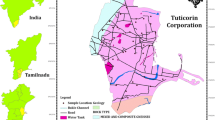Abstract
High levels of fluoride in drinking water affect millions of people due to health problems associated with water consumption. Fluoride concentrations in groundwaters from the unsaturated and saturated zones of a watershed located in the Chaco-Pampean Plain of Argentina are reported and investigated to evaluate the mechanism that controls these concentrations. Two hypotheses were formulated: (a) the adsorption hypothesis, which assumes that fluoride is controlled by adsorption/desorption processes on mineral oxides, and (b) the dissolution hypothesis, which assumes that the solubility of fluorite is the controlling process. Calculations with the CD-MUSIC surface complexation model to test the adsorption hypothesis rendered very poor results. The affinity of fluoride for surface sites is so low that it is easily displaced by carbonate, and thus the calculated fluoride–carbonate trends are very different to the experimentally found with the studied water samples. On the contrary, a comparison of reaction quotients, Q, with equilibrium constants, K, for fluorite dissolution, calcite dissolution and a combination of both processes indicates that fluorite and calcite are in equilibrium or close to equilibrium with their corresponding ions in solution, giving strength to the dissolution hypothesis. This hypothesis can also explain, at least qualitatively, why fluoride correlates positively with arsenate and carbonate. The conclusions could be extrapolated to many other systems worldwide, which present these positive correlations.




Similar content being viewed by others
References
Alarcón-Herrera MT, Bundschuh J, Nath B, Nicolli HB, Gutierrez M, Reyes-Gomez VM, Sracek O (2013) Co-occurrence of arsenic and fluoride in groundwater of semi-arid regions in Latin America: genesis, mobility and remediation. J Hazard Mater 262:960–969
Banerjee A (2015) Groundwater fluoride contamination: a reappraisal. Geosci Front 6(2):277–284
Barbiéro L, Van Vliet-Lanoe B (1998) The alkali soils of the middle Niger valley: origins, formation and present evolution. Geoderma 84(4):323–343
Biswas A, Gustafsson JP, Neidhardt H, Halder D, Kundu AK, Chatterjee D, Bhattacharya P (2014) Role of competing ions in the mobilization of arsenic in groundwater of Bengal basin: insight from surface complexation modeling. Water Res 55:30–39
Handa BK (1975) Geochemistry and genesis of fluoride-containing ground waters in India. Groundwater 13(3):275–281
He X, Ma T, Wang Y, Shan H, Deng Y (2013) Hydrogeochemistry of high fluoride groundwater in shallow aquifers, Hangjinhouqi, Hetao plain. J Geochem Explor 135:63–70
Hiemstra T, Van Riemsdijk WH (1996) A surface structural approach to ion adsorption: the charge distribution (CD) model. J Colloid Interface Sci 179(2):488–508
Hiemstra T, Van Riemsdijk WH (2000) Fluoride adsorption on goethite in relation to different types of surface sites. J Colloid Interface Sci 225(1):94–104
Hiemstra T, Van Riemsdijk WH (2006) On the relationship between charge distribution, surface hydration, and the structure of the interface of metal hydroxides. J Colloid Interface Sci 301(1):1–18
Hiemstra T, Rahnemaie R, Van Riemsdijk WH (2004) Surface complexation of carbonate on goethite: IR spectroscopy, structure and charge distribution. J Colloid Interface Sci 278(2):282–290
Jacks G, Sharma VP (1995) Geochemistry of calcic horizons in relation to hillslope processes, southern India. Geoderma 67(3–4):203–214
Keizer MG, Van Riemsdijk WH (1998) ECOSAT: Equilibrium calculation of speciation and transport, technical report. Department Soil Science and Plant Nutrition, Wageningen Agricultural University, Wageningen, The Netherlands
Mubarak A, Olsen RA (1976) Immiscible displacement of the soil solution by centrifugation. Soil Sci Soc Am J 40:329–331
Padhi S, Tokunaga T (2015) Surface complexation modeling of fluoride sorption onto calcite. J Environ Chem Eng 3(3):1892–1900
Puccia V, Limbozzi F, Avena M (2015) Arsenic in porewaters of the unsaturated zone of an argentinean watershed: adsorption and competition with carbonate as important processes that regulate its concentration. Aquat Geochem 21(6):513–534
Rahnemaie R, Hiemstra T, van Riemsdijk WH (2007) Geometry, charge distribution, and surface speciation of phosphate on goethite. Langmuir 23(7):3680–3689
Schecher WD, McAvoy DC (1992) MINEQL+: a software environment for chemical equilibrium modeling. Comput Environ Urban Syst 16(1):65–76
Smedley PL, Nicolli HB, Macdonald DMJ, Barros AJ, Tullio JO (2002) Hydrogeochemistry of arsenic and other inorganic constituents in groundwaters from La Pampa, Argentina. Appl Geochem 17(3):259–284
Smedley PL, Kinniburgh DG, Macdonald DMJ, Nicolli HB, Barros AJ, Tullio JO, Alonso MS (2005) Arsenic associations in sediments from the loess aquifer of La Pampa, Argentina. Appl Geochem 20(5):989–1016
Stollenwerk KG, Breit GN, Welch AH, Yount JC, Whitney JW, Foster AL, Ahmed N (2007) Arsenic attenuation by oxidized aquifer sediments in Bangladesh. Sci Total Environ 379(2–3):133–150
Su C, Wang Y, Xie X, Li J (2013) Aqueous geochemistry of high-fluoride groundwater in Datong Basin, Northern China. J Geochem Explor 135:79–92
Tracy PW, Robbins CW, Lewis GC (1984) Fluorite precipitation in a calcareous soil irrigated with high fluoride water. Soil Sci Soc Am J 48(5):1013–1016
Acknowledgements
This work was financed by CONICET, SECyT-Argentina and SECyT-UNS. VP, FL and MA are members of CONICET.
Author information
Authors and Affiliations
Corresponding author
Additional information
This article is a part of Topical Collection in Environmental Earth Sciences on IV RAGSU–Advances in Geochemistry of the Surface in Argentina, edited by Dr. Americo Iadran Torres and Dr. Pablo Jose Bouza.
Electronic supplementary material
Below is the link to the electronic supplementary material.
Rights and permissions
About this article
Cite this article
Puccia, V., Limbozzi, F. & Avena, M. On the mechanism controlling fluoride concentration in groundwaters of the south of the Province of Buenos Aires, Argentina: adsorption or solubility?. Environ Earth Sci 77, 495 (2018). https://doi.org/10.1007/s12665-018-7678-x
Received:
Accepted:
Published:
DOI: https://doi.org/10.1007/s12665-018-7678-x




